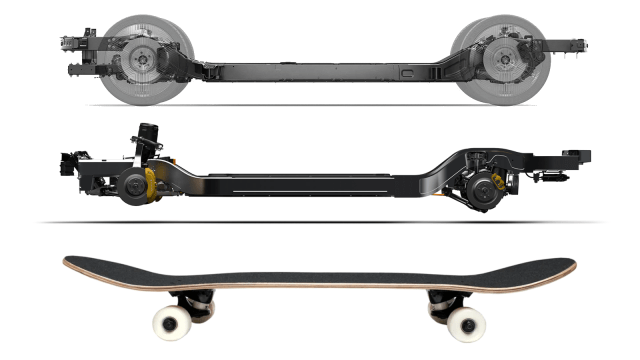People have been talking about the skateboard for a long time. The idea makes sense on the surface: load all the powertrain, suspension, and other important bits in a flat skateboard-like package so you can drop several different bodies on top. A truck, sedan, and van all being carried on the same lower half, saving tons in development and manufacturing costs.
If ever there was a time for the skateboard, it is now. Smaller electric motors package well, batteries can be flattened out and shaped easily, and everything is moving to drive by wire, so soon there won’t be any physical connection between the driver and the wheels.
The dream for OEMs is to use the same skateboard on multiple types of vehicles. But this isn’t super easy for a few reasons. The simplest reason is that those vehicles often have different wheelbases and widths. No big deal; you just change the length of the extrusions and make the skateboard longer, perhaps adding in extra battery modules.
Wheelbase changes also drive other changes, like suspension design. Different vehicle classes sometimes have different ride heights, too. You could maybe add that variation into the adjustability of the mounts, but you still have to account for the fact that a longer and larger vehicle is heavier, further driving changes to the chassis.
Crash is a bigger problem. A change in mass will affect the energy in a crash and require a different structure. For example, in a frontal crash, you need to limit deceleration, so you need some distance in front of the occupant that can crush over a period of time.
The distance would be the same no matter the mass of the vehicle, but a heavier vehicle will need stronger crash rails because it would be dissipating more energy. If you tried to use the stronger crash rails on the lighter vehicle, it wouldn’t crush them enough, and the deceleration would be higher (and less safe) for the occupant. This is a simple example, but a change in mass affects all sorts of crash dynamics. So it’s not really realistic for a coupe and a van to share the same crash structure.
Why not leave the crash structure on the top half? At that point, you might as well just have a front and rear subframe. All the “skateboard” would be doing is connecting the two together, and we’ve been doing that for years.
A skateboard could hold the battery and be a larger area to attach the top body to, but that isn’t necessarily a benefit. The body needs to be fastened to the skateboard, and this creates some problems. People talk about Tesla’s skateboard, but what you see in the Tesla store is just the bottom half of the body.
The top half is not just bolted on, but permanently attached with lots of rivets, adhesive, fasteners, and welds. You could do this with a skateboard too, but having those connection points largely dictates where you put things like B pillars, door flanges, and firewalls, limiting the style of vehicle that can be put on them. Adding connection features to allow for variation adds cost and mass, and in the end that could end up costing more than you save by having a common lower half.
An OEM using a skateboard for multiple types of vehicles comes with lots of challenges, but we may well see someone succeed in the near future. With electric motors, we might see more common subframes: motors and gearboxes contained in a structure that picks up all the suspension points, steering, and brake components. But if you plan to build different classes of vehicles in any serious numbers, as most manufacturers do, there’s probably still an advantage to be gained by optimising those parts for individual cars.
Instead of one company using a skateboard on its different vehicles, the idea may still find its place as a supplier part used by different manufacturers to make similarly sized vehicles. This approach would commonise some vehicle designs, driven by the constraints noted above, but could be great in reducing overall cost.
We’ve suggested previously that Tesla should do this, and Canoo has recently announced an agreement with Hyundai that sounds like it could turn into this. The really exciting part of this is that if a supplier starts selling electric skateboards to different OEMs, then the economy of scale will bring the prices down so that we can bring coachbuilders back to make limited run or one-off cars that don’t cost a million dollars.
Also, consider the fact that you could bolt snowboard boots to the skateboard and drive around using an RC car controller, riding it like an actual skateboard. Will it end horrifically and painfully? Very likely, but imagine the YouTube views.
